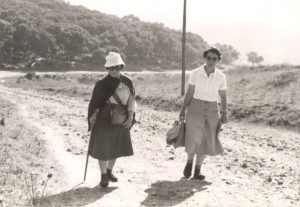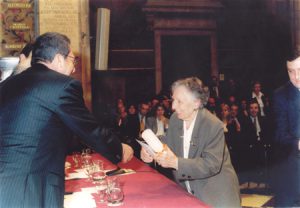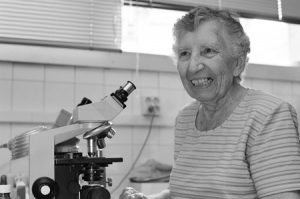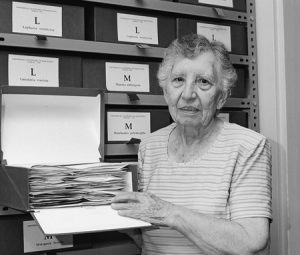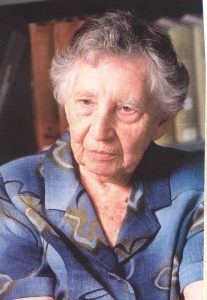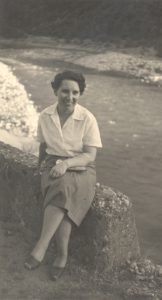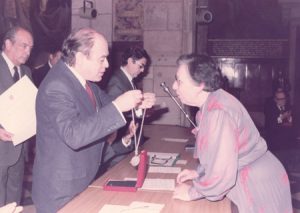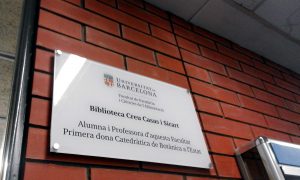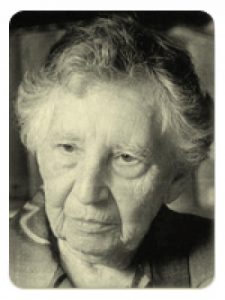
Professor Emeritus of the Universitat Autònoma de Barcelona, was the first woman admitted as a member of the Institut d´Estudis Catalans, Section of Biological Sciences (l978) and President of the Institució Catalana d´Història Natural (1980-81), affiliated Society of the Institut d’Estudis Catalans. She was also member of the Reial Acadèmia de Farmàcia de Catalunya.
Although her academic training was in pharmacy, she did not completely devote to research and teaching until 1967, when she was appointed assistant teacher of Phytogeography at the Faculty of Biology of the Universitat de Barcelona and later Professor of Botany at the Faculty of Sciences of the Universitat Autònoma de Barcelona.
Chemist (and also a nurse) of formation, began working at the University of Barcelona with the Dr. Pius Font i Quer in 1937. After the war combined the work of research with other works. From 1950 to 1967 it was teacher aiding, assisting and responsible of the chair of Botany at the Faculty of Pharmacy of the University of Barcelona and in 1967 it was teacher added of Phytogeography at the Faculty of Biology of the same university. Later, the 1971, was Professor of Botany at the Faculty of Sciences the University of Barcelona, which converted her as the first woman professor of this matter in Catalonia and at the Spanish state.
She oriented her research on bryology, a branch of botany scarcely developed in Spain. Although she focused her studies in the Catalonian Countries, her influence and her works cover the whole Iberian Peninsula. She initiated the meetings called “Reuniones de Briología”, which culminated in 1989 with the organization of the Sociedad Española de Briología, of which she was the first President. She conferred a remarkable drive to criptogamy, in collaboration with other criptogamists she initiated the “Simposios de Botánica Criptogámica”, which are held every two years.
During the fifties she started a herbarium of bryophytes which is currently the most outstanding of the Spanish country considering the high number of species included in it (it contains more than 55.000 samples). This was achieved thanks to her own recollections and those of her collaborators, and many other samples were obtained as exchanges with international bryologists.
She published the first catalogues of bryophytes of Spain, the flora of bryophytes of the Catalonian Countries and the Iberian Peninsula, as well as the Red List of Threatened Species of the Iberian bryophytes.
Perseverance, rigour and enthusiasm for bryology and for any other branch of botany were the most remarkable attitudes of Creu Casas. She knew how to communicate them to her students. Generosity and humility are good descriptors of her personality. The progress of bryology in the Spanish country could only be explained by the support she has been giving to young researchers of this discipline. Thanks to her to her dedication, as well as of their collaborators, the knowledge of bryophytes in the Iberian Peninsula has greatly improved.
In 1983 she received the Narcís Monturiol Medal for Scientific and Technological Merit, and in 2002, the Fundació Catalana Prize for Research and the Serra d’Or Critical Prize for the mentioned bryophytic flora of the Catalan Countries.
The library of the Faculty of Pharmacy and Food Sciences of the University of Barcelona dedicated its library to Dr. Creu Casas (11.03.2019).
She has published more than 200 scientific works, of which we stand out the following:
- Catálogo de los briófitos de la vertiente española del Pirineo Central y de Andorra. 1986.
- New Checklist of spanish mosses. 1991.
- The Anthocerothae and Hepaticae of Spain and Balearic Islands: a preliminary checklist. 1998.
- Cartografia de Briòfits. Península Ibèrica i les illes Balears, Canàries, Açores i Madeira. Fasc. 1-4. 1985-1986. I. E. C..
- Flora dels briòfits del Països Catalans. I Molses. 2001. I. E. C.
- Flora dels briòfits del Països Catalans. II Hepàtiques i antocerotes. 2004. I. E. C.


